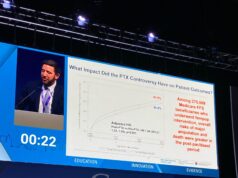A retrospective analysis from Wales, UK, reported at CIRSE 2014, finds that although there are no randomised controlled trials comparing open and endovascular repair of mycotic aortic aneurysms in the thorax and abdomen, endovascular aneurysm repair (EVAR) in these patients is favourable.
Bethan A Conrad, Medical School, Cardiff University, Wales, United Kingdom, told delegates that the study added to the growing body of evidence to support EVAR as a viable treatment option for mycotic aneurysms.
Conrad alluded to the fact that despite mycotic/inflammatory aneurysms of the thoracic and abdominal aorta having been treated by endovascular repair (EVAR) at their centre for the last 17 years, little evidence of its effectiveness exists in the literature. “This retrospective analysis aims to evaluate our experience and assess whether EVAR should be a standard approach for such patients,” she noted.
The study included all the patients who underwent EVAR at the University Hospital of Wales between 2007 and 2013 for mycotic aneurysms (n=20). The researchers assessed radiological and clinical data for information such as demographics, anatomy, biochemical markers, procedural information and follow-up (including re-intervention, morbidity and mortality).
Conrad reported that there were 18 male and two female patients with a mean age of 73 (range 54–84), with 6 thoracic mycotic aortic aneurysms and 14 abdominal ones. Primary technical success was 100% with no immediate complications. The mean follow-up was 26 months (range 0–69 months). “There were two cases (10%) of 30-day mortality. These were both abdominal EVAR cases and we believe were a result of the underlying disease processes, rather than the procedure,” Conrad said.
She also reported that re-intervention was required in one (5%) patient who had a mycotic abdominal aortic aneurysm and this case required surgical bypass of an occluded aortoun- iliac stent graft. No cases required explantation of the stent-graft.
“To date, this is the largest reported series of mycotic aortic anerusysms treated with EVAR in the world. Patients with mycotic aneurysms are often critically ill, and open surgical repair has significant associated morbidity and mortality in these patients. Our centre will continue performing EVAR as the first line in patients with anatomically-suitable abdominal/thoracic mycotic aortic aneurysms,” Conrad concluded.












